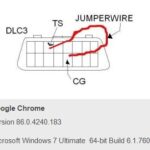Determining whether your 1997 Honda Accord is equipped with OBD1 or OBD2 can sometimes be confusing. This distinction is crucial for diagnostics, repairs, and ensuring your vehicle meets emission standards. For Honda Accord owners, especially those with the 1997 model year, understanding the OBD standard is the first step in effective car maintenance. Let’s clarify how to identify if your 1997 Honda Accord uses OBD1 or OBD2 systems.
The key to identifying your 1997 Honda Accord’s OBD system lies in examining both the engine sensors and the diagnostic port itself. OBD2, the newer standard, typically features a more standardized diagnostic port location and sensor setup compared to OBD1.
One significant difference, particularly relevant to the Honda F22B1 engine often found in 1997 Accords, is the location of the crankshaft position sensor (CKP) and top dead center sensor (TDC). On an OBD2 F22B1 engine, you’ll generally find the CKP sensor positioned on the engine block, potentially near the timing belt cover. In contrast, the OBD1 version of the F22B1 engine usually integrates all three primary sensors – CKP, TDC, and cylinder position sensor (CYP) – within the distributor.
To visually inspect for an OBD2 setup, check the engine block, specifically near the timing belt cover on the firewall side. Look for a wire harness that might be present but not connected to any sensor. This could indicate the presence of an OBD2-style CKP/TDC sensor setup, even if it’s not immediately obvious.
Another important identifier is the distributor wiring. Counting the number of wires going to your distributor can provide clues. An OBD1 distributor setup tends to have more wires compared to an OBD2 conversion that utilizes a harness adapter. Some conversions use a harness extension to bridge the OBD2 CKP/TDC connector near the timing belt cover to an OBD1 distributor. This often involves adapting the 4-pin OBD2 CKP/TDC connector to work with the OBD1 distributor’s sensor inputs.
If you are encountering a Check Engine Light (CEL) and are trying to diagnose sensor issues, especially after suspecting an OBD1 to OBD2 conversion or vice versa, examining sensor waveforms can be helpful. Using an oscilloscope to check the signals from the CKP, TDC, and CYP sensors at the ECU pins can reveal inconsistencies or signal problems. For instance, comparing TDC and CYP waveforms might highlight synchronization issues, where the CYP signal appears slightly out of sync with the TDC signal. While some level of offset might be normal, significant discrepancies could indicate a problem with sensor compatibility or wiring.
If your 1997 Honda Accord is experiencing a CEL that appears intermittently, particularly after driving for a while, it’s crucial to accurately determine the OBD standard. Incorrectly diagnosing the system can lead to misinterpretations of error codes and ineffective repairs. Even if the car seems to run well, a persistent CEL will prevent it from passing inspection, making accurate OBD identification and troubleshooting essential for maintaining your 1997 Honda Accord’s roadworthiness and compliance.
